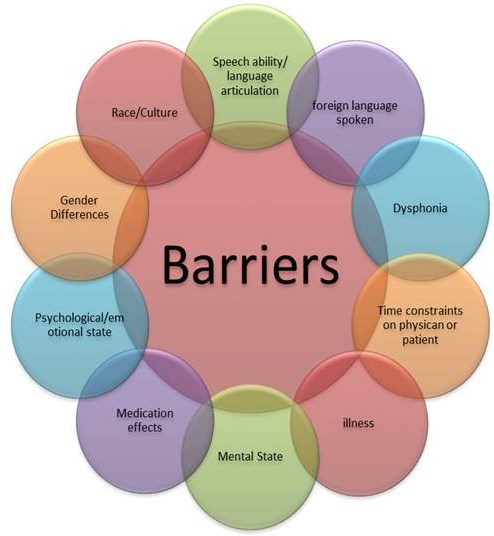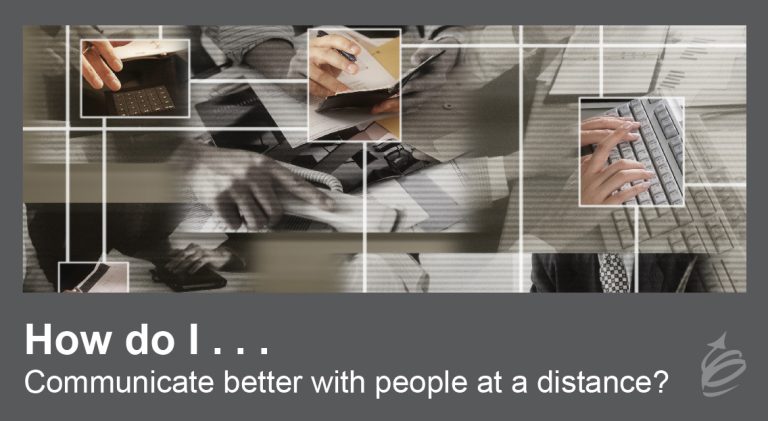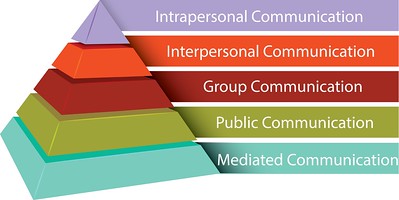Why is Communication Complex?
Communication is complex due to the involvement of various factors and the potential for misinterpretation. It encompasses verbal and non-verbal cues, cultural differences, differing perspectives, and the use of technology for transmitting messages.
Effective communication requires understanding and consideration of these complexities to ensure clear and accurate exchange of information. In today’s fast-paced and interconnected world, effective communication has become even more vital for building relationships, driving business success, and fostering collaboration. Understanding the complexities of communication enables individuals and organizations to navigate challenges, bridge gaps, and achieve mutual understanding.
By recognizing the intricacies involved in communication, we can strive for clarity, empathy, and effective information transfer in various personal and professional contexts.

Credit: www.inc.com
The Intricacies Of Human Communication
Human communication is a complex web of intricacies, woven together by a multitude of factors. From verbal and nonverbal cues to cultural differences and emotional context, understanding why communication is complex requires a careful examination of these elements and their interplay.
Communication is a fascinating and complex aspect of human behavior. It plays a pivotal role in our everyday lives, shaping our relationships, experiences, and even our identities. The ability to express ourselves and understand others is a fundamental part of being human.
It is through communication that we connect, share ideas, convey emotions, and navigate the world around us. However, the multifaceted nature of communication can make it both challenging and intriguing.
Communication As A Fundamental Human Behavior
- Language as a key component: One of the primary ways humans communicate is through language. Whether spoken or written, language allows us to convey thoughts, ideas, and emotions. It provides a structured system of symbols and rules that enable us to understand and be understood.
- Non-verbal communication: Besides language, non-verbal cues also play a crucial role in communication. Facial expressions, body language, tone of voice, and even eye contact can convey meaning and shape interactions. These non-verbal cues often add layers of complexity to our communication, enriching the overall message.
- Contextual factors: Communication is heavily influenced by the context in which it occurs. Cultural norms, social settings, and personal backgrounds all impact the way we communicate. Different cultures and societies have varying communication styles, etiquette, and norms, which can sometimes lead to misunderstandings and challenges in cross-cultural interactions.
- Subjectivity in interpretation: One of the complexities of communication lies in the fact that it is inherently subjective. Each individual brings their own unique set of experiences, beliefs, and perspectives, which shape how they interpret and understand messages. This subjectivity can sometimes lead to miscommunication or differing interpretations of the same communication.
- Technology and communication: In today’s digital age, technology has transformed the way we communicate. The rise of social media, messaging platforms, and video calls has changed the dynamics of human interaction. While technology has made communication more convenient and accessible, it has also introduced new challenges, such as the potential for misinterpretation and the risk of miscommunication due to the absence of non-verbal cues.
The intricacies of human communication stem from its multifaceted nature. Language, non-verbal cues, contextual factors, subjectivity, and technology all contribute to the complexity of our interactions. Understanding and navigating these complexities is essential for effective communication and fostering meaningful connections with others.
Language Barriers
Communication can be complex due to language barriers, hindering effective understanding and interaction. These barriers make it challenging to convey ideas and information accurately, potentially leading to misunderstandings and miscommunication.
Communication is a complex process, and one of the main reasons for this complexity is the presence of language barriers. When people from different linguistic backgrounds interact, it can create misunderstandings and impede effective communication. Let’s explore some of the key factors that contribute to language barriers:
Cultural Differences:
- Different cultural contexts can give rise to variations in language use and interpretation.
- Idioms and cultural references may not have direct translations, leading to confusion.
- Cultural norms and values can influence communication styles and expectations.
Different Communication Styles:
- Direct vs indirect: Some cultures prefer straightforward and explicit communication, while others rely on subtle cues and indirect messages.
- High context vs low context: In high-context cultures, much of the information is implied and understood within the context, whereas low-context cultures rely on explicit communication.
- Verbal vs non-verbal: The importance placed on verbal communication varies across cultures, with some relying heavily on non-verbal cues such as body language and gestures.
Navigating language barriers requires a mix of patience, active listening, and cultural understanding. By being aware of the challenges posed by these barriers, individuals and organizations can take proactive steps to enhance communication and bridge the gaps between language and culture.
Non-Verbal Communication Challenges
Communication can be complex due to various non-verbal challenges, including body language, facial expressions, and tone of voice. These factors greatly influence how messages are interpreted and can lead to misunderstandings if not carefully managed.
Body Language:
- In communication, words are not the only way to convey meaning. Non-verbal cues play a vital role in understanding the messages we send and receive. Let’s explore some of the challenges associated with non-verbal communication, specifically in the context of body language and facial expressions.
Body Language:
- Body language is a powerful form of non-verbal communication that often speaks louder than words. It encompasses a wide range of gestures, postures, and movements that can convey emotions, attitudes, and intentions. However, interpreting body language correctly can be complex due to various factors. Here are some challenges associated with body language:
- Different cultural norms: Each culture has its own set of body language cues, and what may be interpreted as friendly or positive in one culture can be perceived as offensive or negative in another. It is essential to be aware of these cultural differences to avoid miscommunications and misunderstandings.
- Individual differences: Just as cultures have unique body language interpretations, individuals also exhibit specific non-verbal cues based on their personalities, upbringing, and experiences. One gesture may have different meanings for different people. Understanding and decoding these individual differences can be challenging.
- Contextual ambiguity: Body language can be highly context-dependent, which means the same gesture can have different interpretations depending on the situation. For instance, crossing arms can indicate defensiveness or simply a comfortable position. Deciphering the intended meaning requires considering the broader context in which the body language is displayed.
- Incongruence with verbal communication: Sometimes, non-verbal cues can contradict the spoken words, leading to confusion or mixed messages. For example, someone might say they are fine while clenched fists and a tense body posture suggest otherwise. Identifying and resolving such inconsistencies require careful observation and attentive listening.
- Subtlety and nuance: Body language often involves subtle nuances that can easily go unnoticed or misinterpreted. Microexpressions, slight head nods, or shifts in posture can convey important information, but these subtle cues may require a keen eye and attentive observation to decipher accurately.
Understanding body language is an essential skill not only in interpersonal communication but also in professional settings. By paying attention to both verbal and non-verbal cues, we can gain a deeper understanding of others and enhance the effectiveness of our communication.
Remember to be mindful of cultural differences, individual variations, contextual factors, and the subtle nuances of body language to ensure clear and accurate communication.
Technological Influences
Communication becomes complex due to various technological influences, such as the rapid advancement of digital platforms, increasing reliance on virtual interactions, and the constant need to adapt to evolving communication tools and techniques. These factors contribute to the intricacies of conveying messages effectively in today’s interconnected world.
Technology has undoubtedly revolutionized the way we communicate, making it more convenient and instantaneous. But it has also added complexities to our interactions, leading to misinterpretations and misunderstandings. In this section, we will explore the technological influences that contribute to the complexity of communication.
Digital Communication Platforms
Digital communication platforms have become an integral part of our daily lives, providing us with various ways to connect and share information. However, these platforms bring their own set of challenges that complicate communication:
- Shortened messages and abbreviations: Social media and messaging platforms often limit the number of characters we can use in a message. This results in the use of abbreviations and acronyms, which can be difficult to decipher and may lead to confusion.
- Lack of nonverbal cues: Nonverbal cues such as facial expressions, body language, and tone of voice play a crucial role in conveying emotions and intentions. In digital communication, these cues are often absent, making it harder to accurately interpret the tone and intention behind a message, leading to misunderstandings.
- Overreliance on text: While digital communication platforms offer various forms of media such as images, videos, and voice recordings, text-based messages remain the primary means of communication. Without the context provided by other forms of media, messages can be easily misinterpreted or lacking in clarity.
- Time delays and asynchronous communication: Unlike face-to-face conversations or phone calls, digital communication often happens asynchronously. Messages may be sent and received with delays, leading to disjointed conversations and misinterpretations.
Misinterpretation Of Tone And Intention
Another significant factor contributing to the complexity of communication is the misinterpretation of tone and intention. Our tone and intention are highly dependent on nonverbal cues, such as facial expressions and body language, which are not always effectively conveyed through digital platforms.
Here are some reasons why misinterpretation occurs:
- Lack of visual cues: In face-to-face communication, visual cues allow us to gauge someone’s emotional state and intentions. These cues are absent in digital communication, leaving room for misinterpretation.
- Ambiguity in text-based messages: Text-based messages often lack the nuance and context necessary to accurately convey tone and intention. Subtle cues, such as sarcasm or humor, can easily be misinterpreted, leading to misunderstandings.
- Different interpretation by individuals: Each person has their own unique communication style and interpretation of messages. What may seem clear and straightforward to one person may be ambiguous or confusing to another, resulting in miscommunication.
- Foreign language and cultural barriers: Communication across different languages and cultures adds another layer of complexity. Translating phrases and expressions can be challenging, leading to misinterpretations of tone and intention.
The rise of digital communication platforms and the limitations they pose, coupled with the misinterpretation of tone and intention, have made communication more complex than ever. Being aware of these challenges can help us navigate digital interactions more effectively and strive for clearer and more meaningful communication.
Processing Information
Communication becomes complex because of the intricate process of processing information.
Processing information is a fundamental aspect of communication, and it plays a significant role in why communication is complex. Our minds are constantly inundated with a vast amount of information, and the way we process and interpret that information can impact our ability to effectively communicate.
In this section, we will explore two key factors that contribute to the complexity of processing information in communication: selective attention and cognitive biases.
Selective Attention:
- Our brains have limited capacity, and we cannot attend to all incoming information simultaneously.
- Selective attention allows us to focus on specific stimuli while filtering out others.
- When communicating, individuals may prioritize certain information based on personal interests, motives, or relevance to their goals.
- Different people may exhibit varying levels of selective attention, which can affect the interpretation and understanding of the message being communicated.
- Factors such as distractions, emotions, and individual cognitive abilities can influence selective attention during communication.
Cognitive Biases:
- Cognitive biases are mental shortcuts or patterns of thinking that can lead to systematic deviations from rational judgment.
- These biases can influence the way we interpret and understand information during communication.
- Confirmation bias, for example, leads individuals to seek and interpret information in a way that confirms their existing beliefs.
- Anchoring bias occurs when individuals rely heavily on the first piece of information they receive, even if it may not be relevant or accurate.
- The halo effect bias involves generalizing positive or negative traits about a person or entity based on initial impressions.
- These biases can create barriers to effective communication by distorting the way information is processed and understood.
The complexity of communication is largely attributed to how we process and interpret information. Selective attention and cognitive biases play a significant role in shaping our understanding of messages and can impact the effectiveness of communication. Being aware of these factors can help us navigate the complexities and strive for clearer and more effective communication.
Emotional Intelligence
Communication can be complex due to emotional intelligence. Understanding and managing emotions is essential in navigating the intricacies of effective communication. Emotional intelligence helps individuals recognize and empathize with others, enhancing their ability to convey messages clearly and build meaningful connections.
Why Is Communication Complex?
Communication is a crucial aspect of our daily lives, allowing us to connect and convey our thoughts, ideas, and emotions to others. Despite its importance, communication can be complex and challenging due to various factors. One such factor is emotional intelligence, which plays a significant role in the way we communicate and interact with others.
Managing Emotions In Communication:
In the realm of communication, emotions can greatly influence the effectiveness and outcomes of our interactions. Managing emotions skillfully is fundamental in achieving successful communication. Here are some key points to consider:
- Recognizing emotions: Acknowledging and understanding our own emotions, as well as those of others, helps create a foundation for effective communication. By being aware of our emotional state, we can better navigate conversations and respond appropriately.
- Controlling emotional reactions: Emotions can sometimes cloud our judgment and lead to impulsive reactions. Developing the ability to control our emotional reactions enables us to respond thoughtfully and constructively, even in challenging situations.
- Expressing emotions effectively: The way we express our emotions can significantly impact how we are perceived and understood by others. Finding the right balance between expressing emotions authentically and considering the impact on others allows for clearer communication.
- Active listening: Emotionally intelligent communication involves not only expressing emotions but also actively listening to others. This means paying attention to both verbal and non-verbal cues, showing empathy, and demonstrating genuine understanding.
- Adapting to different emotional styles: Each individual has their unique emotional style and preferences for communication. Being adaptable and receptive to different emotional styles allows for better connection and understanding in conversations.
Empathy And Understanding:
Empathy and understanding are integral components of emotional intelligence that contribute to effective communication. Here’s what you need to know:
- Empathy: Empathy is the ability to understand and share the feelings of another person. It involves putting ourselves in someone else’s shoes, recognizing their emotions, and responding with compassion and understanding.
- Active empathy: Active empathy goes beyond simply recognizing emotions; it involves actively engaging with others and demonstrating genuine interest in their experiences and emotions. This type of empathy fosters a deeper connection and promotes meaningful communication.
- Cultivating understanding: Understanding goes hand in hand with empathy. Seeking to understand different perspectives and experiences allows us to broaden our own viewpoints and engage in more inclusive and meaningful conversations.
- Non-judgmental attitude: To create a safe and open space for communication, it is essential to adopt a non-judgmental attitude. This means refraining from making assumptions or jumping to conclusions based on emotions expressed by others.
- Validation and support: Validating the emotions of others and offering support can significantly enhance communication. By acknowledging and accepting someone’s feelings, we create an environment where individuals feel heard and valued.
Emotional intelligence, including managing emotions in communication and demonstrating empathy and understanding, plays a vital role in navigating the complexities of communication. Developing these skills enables us to connect better with others, build stronger relationships, and achieve more effective and fruitful interactions.
Perceptions And Misinterpretations
Communication is a complex process, often influenced by perceptions and misinterpretations. With various factors such as language barriers, cultural differences, and individual perspectives, understanding and conveying a message accurately can be challenging.
Communication is a complex process influenced by various factors such as perceptions and misinterpretations. In this section, we will explore how stereotypes and preconceived notions, as well as a lack of clarity and effective listening, contribute to the intricacies of communication.
Stereotypes And Preconceived Notions
- Stereotypes, formed by generalizations and assumptions, can hinder effective communication. Here are some key points to consider:
- Stereotypes create bias: Prejudiced beliefs about certain individuals or groups can lead to biased interpretations of their communication.
- Misjudging intentions: Stereotypes often lead to misattributing intentions behind communication, potentially causing misinterpretations.
- Hindered empathy: Stereotyping can obstruct our ability to empathize with others, hindering understanding and connection.
Lack Of Clarity And Effective Listening
- Effective communication heavily relies on clarity and active listening. The following points highlight the challenges that arise when clarity and effective listening are lacking:
- Ambiguity breeds confusion: Lack of clarity in expressing thoughts or ideas increases the risk of miscommunication and misunderstanding.
- Failure to understand nonverbal cues: Effective listening encompasses not only verbal communication but also nonverbal cues such as body language and tone of voice. Ignoring these cues can lead to misinterpretations.
- Inattentiveness impedes understanding: When individuals fail to actively listen, they miss crucial details and do not fully comprehend the message being communicated.
By being aware of stereotypes and preconceived notions, as well as prioritizing clarity and effective listening, we can strive to overcome the complexities of communication. Only then can we foster an environment where understanding, respect, and connection thrive.
Building Effective Communication Skills
Communication is complex due to a variety of factors such as misinterpretation, cultural differences, and emotional barriers. Understanding these complexities is essential to build effective communication skills.
Building effective communication skills is essential in navigating the complexity of communication. It involves actively listening to others, delivering clear and concise messages, and ensuring that the information shared is easily understood. By developing these skills, individuals can enhance their ability to connect, collaborate, and create meaningful relationships in both personal and professional settings.
Let’s explore the key components of effective communication:
Active Listening:
Active listening is the cornerstone of effective communication. It involves fully engaging with the speaker, both verbally and nonverbally, and giving them your undivided attention. Here’s how to improve active listening skills:
- Maintain eye contact with the speaker, showing that you are attentive and interested.
- Avoid interrupting or finishing the speaker’s sentences. Instead, give them the time and space to express themselves fully.
- Use body language to signal your engagement, such as nodding and leaning forward.
- Reflect and paraphrase what the speaker has said to ensure understanding and show that you are actively listening.
- Ask clarifying questions to gain further insight and demonstrate your interest in their perspective.
Active listening fosters effective communication by building rapport, understanding diverse viewpoints, and resolving conflicts.
Clear And Concise Messaging:
Clear and concise messaging is crucial for ensuring that information is accurately conveyed and easily understood. Here are some tips for improving your messaging skills:
- Organize your thoughts before communicating. Structuring your message helps to convey information in a logical and coherent manner.
- Use simple and straightforward language, avoiding jargon or complex terms that may confuse your audience.
- Be mindful of your tone and body language, as they can influence how your message is perceived.
- Focus on the key points and avoid unnecessary elaboration or digressions.
- Use visual aids, such as charts or diagrams, to enhance understanding and engage your audience.
By delivering clear and concise messages, you can minimize misunderstandings, facilitate efficient communication, and ensure that your ideas are effectively conveyed.
Building effective communication skills requires active listening and clear, concise messaging. Developing these skills will enable you to connect with others, foster understanding, and navigate the complexities of communication. Practice active listening to demonstrate your engagement and understanding. Ensure your messages are clear and concise, using simple language and organizing your thoughts effectively.
By focusing on building these skills, you can become a more effective communicator and enhance your overall communication experiences.
Developing Cultural Competence
Effective communication can be complex due to cultural differences, requiring the development of cultural competence to overcome barriers and foster understanding.
Communication is a fundamental part of human interaction, allowing us to convey thoughts, ideas, and emotions. However, communication is complex, as it involves various factors that influence how messages are sent and received. One significant aspect of effective communication is developing cultural competence, which involves understanding different communication styles and engaging in cross-cultural communication training.
Let’s delve into these areas to gain a deeper insight into why communication can be a challenging endeavor.
Understanding Different Communication Styles
- Communication styles vary across cultures, making it crucial to develop an awareness of these differences. Here are some key points to consider:
- Direct vs. Indirect communication: Some cultures prefer direct communication, being explicit and straightforward in expressing thoughts and opinions. In contrast, other cultures emphasize indirect communication, relying on non-verbal cues and subtleties to convey meaning.
- High-context vs. low-context communication: In high-context cultures, meaning is embedded in the context and relationships, requiring individuals to read between the lines. Conversely, low-context cultures place more emphasis on explicit verbal communication.
- Individualistic vs. collectivistic communication: In individualistic cultures, communication often emphasizes individual goals and assertiveness. On the other hand, collectivistic cultures prioritize group harmony and cohesion in communication.
Cross-Cultural Communication Training
- To navigate the complexities of communication in a globalized world, cross-cultural communication training plays a crucial role. Here’s why it’s essential:
- Increased cultural intelligence: Cross-cultural communication training helps individuals develop cultural intelligence, enhancing their ability to interact effectively with people from diverse backgrounds.
- Improved empathy and understanding: Training in cross-cultural communication fosters empathy, allowing individuals to understand perspectives different from their own. This understanding promotes mutual respect and effective communication.
- Enhanced communication skills: By learning about different communication styles, individuals can adapt their communication approach to be more inclusive and considerate of diverse audiences.
- Reduced misunderstandings and conflicts: Effective cross-cultural communication training mitigates misunderstandings and conflicts that can arise due to cultural differences. This leads to smoother and more productive interactions.
Developing cultural competence and engaging in cross-cultural communication training are crucial steps in overcoming the complexities of communication. By understanding and adapting to different communication styles, individuals can bridge the gaps that cultural disparities often present. So, let’s embrace diversity and continue to improve our communication skills for a more connected and inclusive world.
Enhancing Emotional Intelligence
Understanding why communication is complex involves recognizing the role of emotional intelligence in the process. By enhancing emotional intelligence, individuals can navigate the intricacies of communication more effectively, leading to better understanding and connection with others.
Recognizing and managing emotions:
- Emotional intelligence plays a crucial role in effective communication. By being aware of our own emotions and those of others, we can navigate through complex communication scenarios with greater understanding and empathy.
Empathetic communication:
- Empathy is a fundamental skill that fosters deep connection and mutual understanding in communication. When we actively listen and put ourselves in others’ shoes, we can respond with more compassion and build stronger relationships.
- Here are a few ways to enhance empathetic communication:
- Practice active listening: By giving our full attention to the speaker and focusing on understanding their perspective, we can respond genuinely and empathetically.
- Validate emotions: Acknowledge and validate the emotions expressed by others, showing understanding and support.
- Use non-verbal cues: Pay attention to body language and facial expressions, as they can provide additional insight into someone’s emotions.
- Reflect and clarify: Summarize and reflect on what the speaker has shared to ensure accurate understanding and avoid misunderstandings.
Incorporating emotional intelligence and empathy into our communication skills can help us navigate the complexity of human interactions.
Frequently Asked Questions Of Why Is Communication Complex?
What Is Communication Complex?
Communication complex refers to a system that enables the exchange of information between individuals or groups. It includes various elements like verbal and non-verbal cues, technology, and channels for transmitting messages. This complex process involves encoding and decoding messages, establishing effective feedback loops, and ensuring clarity and understanding.
Communication complex is crucial in both personal and professional contexts as it helps foster relationships, share ideas, and collaborate effectively. By utilizing various communication channels such as face-to-face interactions, phone calls, emails, and social media platforms, individuals can communicate efficiently and build strong connections.
Clear and effective communication plays a vital role in promoting understanding, resolving conflicts, and achieving common goals.
Why Is It So Difficult To Communicate?
Communication can be challenging due to various factors. Firstly, lack of clarity in expressing thoughts can lead to misunderstandings. Secondly, differences in language, dialects, or accents can make it difficult to convey messages accurately. Furthermore, communication barriers arise from cultural disparities and diverse communication styles.
Additionally, distractions, such as noise or technological interruptions, can disrupt effective communication. Moreover, emotional factors like stress, anxiety, or personal biases can hinder clear expression or interpretation of ideas. In addition, poor listening skills and the inability to empathize can also contribute to communication difficulties.
It is essential to cultivate active listening, clarity of expression, and cultural awareness to overcome these challenges and enhance effective communication. Promoting open-mindedness and respect towards others’ ideas and perspectives is vital to bridge the communication gap.
What Is The Complexity Of Communication?
The complexity of communication refers to the intricacies involved in conveying and understanding information between individuals or groups. It encompasses various factors, such as language barriers, cultural differences, nonverbal cues, and the interpretation of messages. Effective communication requires clear and concise expression, active listening, empathy, and the ability to adapt to different communication styles.
Misunderstandings can arise due to misinterpretation, incomplete or ambiguous messages, emotional factors, or distractions. To overcome these complexities, effective communication techniques such as active questioning, using examples, active listening, and providing feedback are often employed. Developing good communication skills is crucial in various personal and professional settings to foster understanding, build relationships, and work collaboratively towards common goals.
Is Communication A Complex Skill?
Communication is a complex skill that involves exchanging ideas, thoughts, and information. It requires the ability to both send and receive messages effectively. This skill involves various elements like language, body language, tone, and listening. Effective communication is essential in personal and professional relationships, as it helps in building trust, resolving conflicts, and expressing oneself clearly.
Mastering communication involves understanding the needs and expectations of the audience, adapting the message to different contexts, and choosing the appropriate medium to convey the information. It also requires active listening, empathy, and the ability to interpret non-verbal cues. In a nutshell, communication is a multifaceted skill that requires practice and continuous improvement to effectively convey and understand messages.
Conclusion
Communication is undeniably complex due to a myriad of factors. Firstly, the use of different languages and dialects creates barriers for effective communication. Furthermore, non-verbal cues, such as body language and facial expressions, can be easily misinterpreted, leading to misunderstandings.
Additionally, cultural differences play a significant role in shaping communication styles and expectations. Moreover, the ever-evolving technology landscape has introduced various new communication channels, which can result in information overload and further complicate effective communication. Understanding the nuances and intricacies of communication is crucial in today’s interconnected world.
By recognizing the complexity of communication, individuals and organizations can take proactive steps to improve it. This includes developing cultural competence, actively listening, and utilizing technology in an intentional and mindful manner. By doing so, we can bridge gaps, fostering stronger relationships and enhancing mutual understanding.
In this way, effective communication becomes a catalyst for growth, collaboration, and positive change. So, let us embrace the complexity of communication and work towards mastering its intricacies for a more harmonious and connected world.




